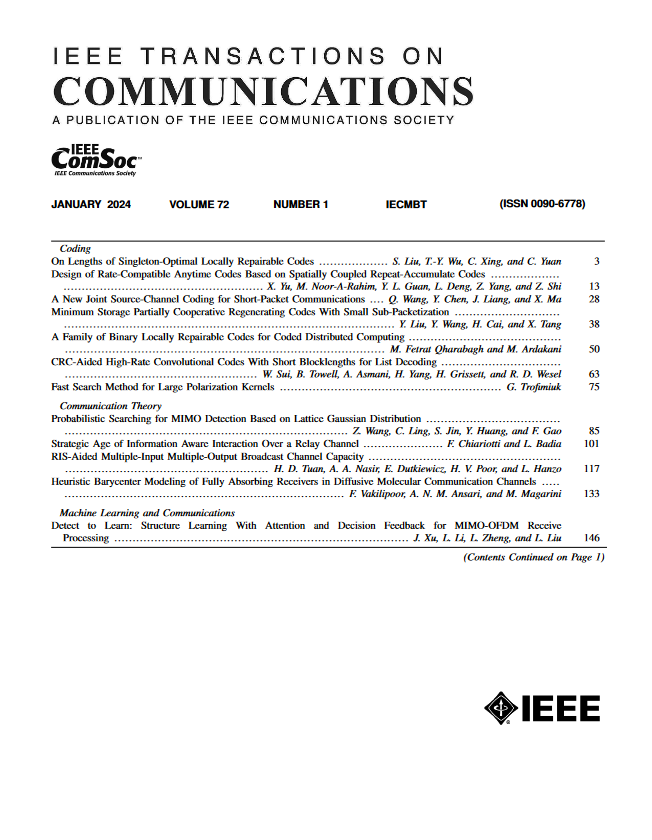T3DRIS: Advancing Conformal RIS Design Through In-Depth Analysis of Mutual Coupling Effects
IF 8.3
2区 计算机科学
Q1 ENGINEERING, ELECTRICAL & ELECTRONIC
引用次数: 0
Abstract
This paper presents a theoretical and mathematical framework for the design of a conformal reconfigurable intelligent surface (RIS) that adapts to non-planar geometries, which is a critical advancement for the deployment of RIS on non-planar and irregular surfaces as envisioned in smart radio environments. Previous research focused mainly on the optimization of RISs assuming a predetermined shape, while neglecting the intricate interplay between shape optimization, phase optimization, and mutual coupling effects. Our contribution, the Tailored 3D RIS (T3DRIS) framework, addresses this fundamental problem by integrating the configuration and shape optimization of RISs into a unified model and design framework, thus facilitating the application of RIS technology to a wider spectrum of environmental objects. The mathematical core of T3DRIS is rooted in optimizing the 3D deployment of the unit cells and tuning circuits, aiming at maximizing the communication performance. Through rigorous full-wave simulations and a comprehensive set of numerical analyses, we validate the proposed approach and demonstrate its superior performance and applicability over contemporary designs. This study—the first of its kind—paves the way for a new direction in RIS research, emphasizing the importance of a theoretical and mathematical perspective in tackling the challenges of conformal RISs.T3DRIS:通过深入分析相互耦合效应推进共形 RIS 设计
本文提出了一个适用于非平面几何形状的共形可重构智能曲面(RIS)设计的理论和数学框架,这对于在智能无线电环境中设想的非平面和不规则表面上部署RIS是一个关键的进步。以往的研究主要集中在具有预定形状的RISs优化上,而忽略了形状优化、相位优化和相互耦合效应之间复杂的相互作用。我们的贡献是定制3DRIS (T3DRIS)框架,通过将RIS的配置和形状优化集成到统一的模型和设计框架中来解决这个基本问题,从而促进RIS技术在更广泛的环境对象中的应用。T3DRIS的数学核心植根于优化单元格和调谐电路的三维部署,旨在最大化通信性能。通过严格的全波模拟和全面的数值分析,我们验证了所提出的方法,并证明了其优于当代设计的性能和适用性。这项研究为RIS研究的新方向铺平了道路,强调了理论和数学视角在解决保形RISs挑战中的重要性。
本文章由计算机程序翻译,如有差异,请以英文原文为准。
求助全文
约1分钟内获得全文
求助全文
来源期刊

IEEE Transactions on Communications
工程技术-电信学
CiteScore
16.10
自引率
8.40%
发文量
528
审稿时长
4.1 months
期刊介绍:
The IEEE Transactions on Communications is dedicated to publishing high-quality manuscripts that showcase advancements in the state-of-the-art of telecommunications. Our scope encompasses all aspects of telecommunications, including telephone, telegraphy, facsimile, and television, facilitated by electromagnetic propagation methods such as radio, wire, aerial, underground, coaxial, and submarine cables, as well as waveguides, communication satellites, and lasers. We cover telecommunications in various settings, including marine, aeronautical, space, and fixed station services, addressing topics such as repeaters, radio relaying, signal storage, regeneration, error detection and correction, multiplexing, carrier techniques, communication switching systems, data communications, and communication theory. Join us in advancing the field of telecommunications through groundbreaking research and innovation.
 求助内容:
求助内容: 应助结果提醒方式:
应助结果提醒方式:


